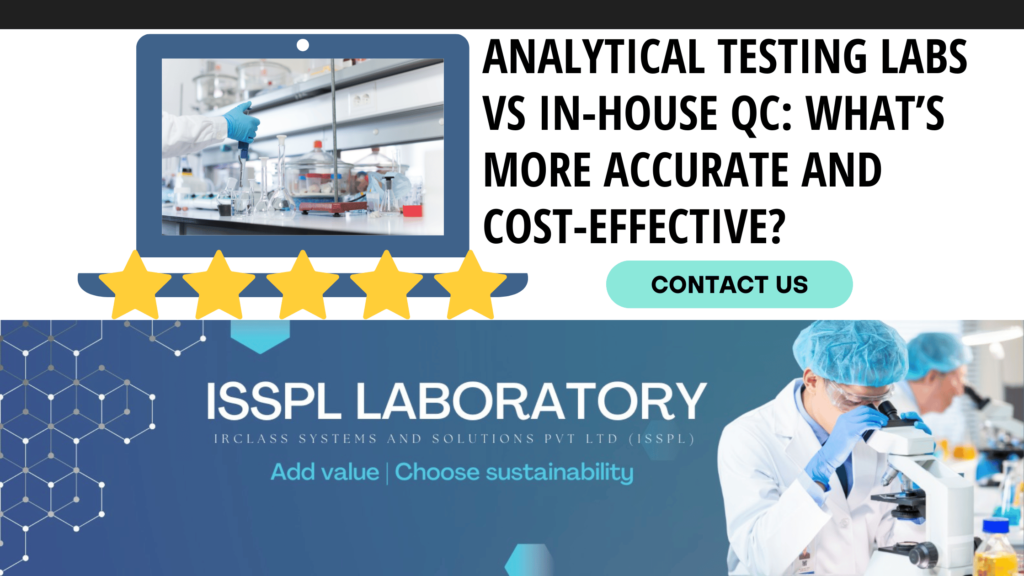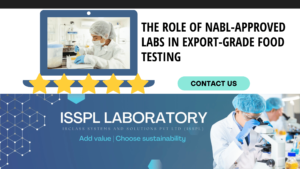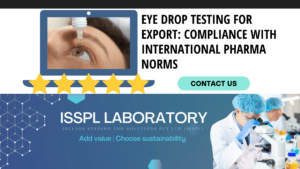An Overview by Team ISSPL - Analytical Testing Laboratory in India
ToggleAny product that is introduced into the market must be safe, reliable, and consistent. This is where quality control is involved. It could be packaged water, food, pharmaceutical, or chemicals, but companies must test what they produce. That can be done in two primary ways, either by using external analytical testing labs or in-house quality control (QC) labs. The choice influences all aspects: price, precision, speed, and conformity.
The same questions are posed by most companies. Which one is more effective? Which of them is more scalable? And, most importantly, which one will not get one into regulatory trouble, and will maintain costs at an affordable level?
Let us break it down.
The Role of Analytical Testing in Quality Assurance
Testing is not a choice. It’s mandatory. All industries have standards, FSSAI and water, CDSCO in pharma, BIS in industrial goods. Such standards demand that products be tested in accordance with various parameters.
Analytical testing assists in detecting problems of raw materials, detecting errors in the production process, and ensuring that the end product is safe and of quality standards. The repercussions of not testing are severe, license revocation, product recall, or even lawsuits.
Therefore, accuracy cannot be compromised whether the testing is done in-house or outsourced.
In-House QC Labs: Direct Control, Higher Fixed Costs
In house QC labs are established within the manufacturing plant. The laboratory is a part of everyday work. The samples are sampled on the line and tested on the spot. This puts the company in full control.
In-house labs:
- Testing is faster
- Operators are familiar with products and production timelines
- Reports are easily integrated into internal systems
- Immediate retesting can be done if something fails
But setting up and maintaining an in-house lab is expensive. Equipment is costly. Trained staff need full-time salaries. The lab must be audited and calibrated regularly. Consumables and chemical standards have to be replenished. Over time, this adds up.
For large companies, this cost is acceptable. For smaller firms, it’s a heavy burden.
Analytical Testing Labs: Independent, Accredited, Scalable
Analytical labs operate independently. Their business is testing. They are certified to carry out testing that’s compliant with national and international norms. Labs accredited by NABL are recognized for their accuracy and traceability.
Companies send samples to these labs when:
- They lack in-house infrastructure
- They need third-party validation for compliance
- They require specific tests not available internally
- They want to reduce overhead
Analytical labs also invest heavily in equipment and automation. This means they can perform high-precision tests with minimal error. Many are specialized. One lab might focus on microbiology. Another on heavy metals or pesticides.
This specialization is more deep. But it also means that samples will need to be sent out, which leads to time lag. Reports can take 2-5 days.

Cost Comparison: Lab Fees vs Infrastructure Investment
Operating an in-house lab is a capital expenditure (CAPEX). Such equipment as gas chromatographs, spectrometers, and microbial incubators are not inexpensive. The lab must also have controlled conditions- temperature, humidity and ventilation systems.
Once installed, it has recurrent expenses: salaries, calibration, reagents, training, maintenance.
Outside laboratories are paid by sample or test. You pay what you consume. This is predictable to small companies. Maintenance or downtime is not an issue. Results are officially valid in case the lab is NABL-accredited.
Here’s how costs typically break down:
• In-house labs require upfront investment of ₹20–50 lakhs for setup
• Monthly operational cost can range from ₹2–5 lakhs
• Third-party labs charge ₹500–₹5000 per test, depending on type and complexity
• High-volume testing may get discounts, but urgent tests may cost more
• Non-compliance penalties (in case of poor testing) can be in lakhs
If you’re testing a high number of batches daily, in-house may be more cost-effective in the long run. But for low to medium volume, outsourcing remains cheaper.
Accuracy: Internal Familiarity vs External Expertise
The in-house labs are near the process. This assists in rapid adaptations. In case of a batch failure, the production can be stopped and recalibrated instantly. Lab technicians are well versed with the product.
However, in-house labs are also subject to bias or control. When auditors discover non-compliant practices, this raises concerns on data integrity.
That risk is eliminated by external labs. Their role is to test not to justify production. They have organized SOPs. There is generally more advanced equipment. Training of staff is done on narrow test categories enhancing consistency.
Labs that are accredited are checked periodically. They are audited and their results can be traced. This makes regulators have confidence in their reports.
Thus, although internal labs are fast, third-party labs are neutral and credible.
Flexibility and Scale
In-house labs are limited to what they were built to test. If a company needs to start testing for a new parameter, it has to invest in new instruments and staff.
External labs are more flexible. If a new regulation is introduced – say, limits for microplastics in water – external labs will usually adopt it first. They update their offerings continuously.
This facilitates the adjustment of companies to the changing standards. It also assists in venturing into export markets where other norms exist.
Compliance and Documentation
All these organizations, FSSAI, NABL, and APEDA, need to be documented. Sample logs, calibration records, test methods and result sheets should be kept. Lack of documents results in fines.
Documentation is a problem in in-house labs. The system can be overwhelmed by the amount of testing that is done daily.
Reports given by external labs are in regulatory formats. Most of them provide digital reports containing QR codes, timestamps, and batch IDs. These are simple to archive and retrieve.
There are even labs that are connected to the company ERP. This eliminates the manual work and minimizes human error.
Security and Data Integrity
Data manipulation is a serious issue. In-house labs may face internal pressure to “adjust” results. This is risky.
Third-party labs work independently. Their results are final. If a batch fails, it’s flagged. This reduces legal exposure. If the matter reaches court or regulator review, external reports hold more weight.
This makes third-party labs a safer option when brand image or legal risk is involved.
Best Practice: Hybrid Approach
Many companies now use a hybrid model. Critical tests are done in-house. Compliance and validation tests are outsourced. This ensures speed and control without losing credibility.
Conclusion
The choice of whether to use in-house QC or third-party testing labs is determined by volume, risk and budget. In-house labs are quick and controlled, but they are expensive to maintain. External labs are accurate, credible in terms of compliance and cheaper in the initial cost. Both are needed.
The smartest approach is often a hybrid one. Daily checks can happen in-house. Third-party labs can handle compliance testing and validations.
Whichever option is chosen, accuracy and documentation are non-negotiable. FSSAI, NABL, and APEDA require strict adherence. Failure can cost more than just money.
IRCLASS Systems and Solutions Pvt. Ltd. (ISSPL) helps companies build the digital and AV infrastructure they need to run smart, compliant labs. Their solutions support testing workflows, improve traceability, and ensure companies are audit-ready. In a world where testing can make or break a brand, ISSPL is helping organizations stay prepared, precise, and protected.







